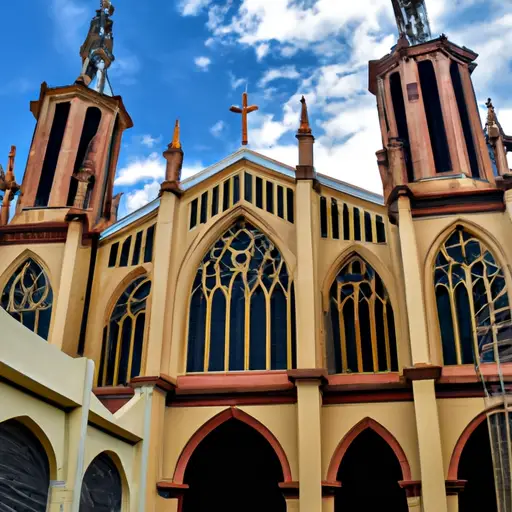Basílica Catedral Santa Cruz – La Vega : Interesting Facts, Information & Travel Guide

- By
- Aparna Patel
- |
- 24 Jun, 2023
- |

Basílica Catedral Santa Cruz de la Vega is one of the most impressive religious structures in the Dominican Republic. It is a stunning example of Baroque architecture, with its flawless and intricate details making it a true work of art. Built in the 15th century, the basilica is renowned for its intricate, gold-laden interior and its remarkable stained glass windows. The cathedral is also known for its great religious importance, as it served as a place of worship for the majority of La Vega’s population. This blog post will provide an overview of the Basílica Catedral Santa Cruz de la Vega, discussing its incredible architecture, interesting history and its spiritual significance. Additionally, this guide will provide an insight into the best way to experience the cathedral. So if you’re looking for some interesting facts about one of the Dominican Republic’s most important religious structures, then read on and join us on this journey.
Interesting Facts About Basílica Catedral Santa Cruz – La Vega
1. The Basílica Catedral Santa Cruz de La Vega was originally built in 1552.
2. It is the oldest Catholic Church in the Dominican Republic.
3. It is a major tourist attraction and is visited by hundreds of people every week.
4. Inside the Basilica, there is a large painting of the Coronation of the Virgin Mary.
5. The altarpiece of the Basilica was designed by a French sculptor.
6. Adjacent to the Basilica is a cemetery, where many famous Dominicans are buried.
7. The Basilica is dedicated to the Holy Cross and includes many artifacts from around the world.
8. It is believed that a miracle occurred within the walls of the church in 1608.
9. There are traditional Dominican balcony balconies on each side of the Basilica.
10. The church is adorned with many murals and sculptures that represent Dominican culture.
History & Information About Basílica Catedral Santa Cruz – La Vega
Basílica Catedral Santa Cruz – La Vega is a Roman Catholic church located in La Vega, Dominican Republic. The church was built in 1560 by order of Doña Ana de Velasco and her husband Captain Francisco Colón, a relative of Christopher Columbus. It was consecrated in 1576. It is the oldest standing church in the Dominican Republic. The church was declared a national monument in 1942 and was declared a basilica in 1954.
The church has a Gothic-style tower which was added in 1738. The interior is richly decorated with wood altars, stained glass windows, and several gilded altarpieces. The exterior is comprised of yellow-orange stone walls with pointed arches.
The church is famous for its annual procession or “entrada” which celebrates the feast day of Jesus of Nazareth. The procession includes a parade of religious figures, over 2,000 people walking in pairs holding candles, and a brass band playing traditional Dominican music. The procession is held every year on the last Sunday of August.
Basílica Catedral Santa Cruz – La Vega is an important cultural site in the Dominican Republic and serves as a reminder of the country’s religious and cultural heritage.
- Balneario El Limón – Samaná : Interesting Facts, Information & Travel Guide
- Basilica Cathedral of Santa María la Menor – Santo Domingo : Interesting Facts, Information & Travel Guide
Frequently Asked Questions About Basílica Catedral Santa Cruz – La Vega
Q: What is the history of Basílica Catedral Santa Cruz – La Vega?
A: Basílica Catedral Santa Cruz – La Vega was founded in 1558 and is now the oldest Catholic Church in Latin America. The church was built in the Neo-Gothic style and is known for its impressive spires and stained-glass windows. The original church was destroyed by an earthquake in 1857, and the new structure was consecrated in 1888.
Q: What architectural features does Basílica Catedral Santa Cruz – La Vega have?
A: Basílica Catedral Santa Cruz – La Vega has a variety of impressive architectural features, including three large spires, two towers, a choir loft, a portico, and a magnificent rose window. Inside the church, visitors will find a large, ornate altar, tall stained-glass windows, a Marian shrine, and a host of other ornate decorations.
Q: Is there any special significance associated with Basílica Catedral Santa Cruz – La Vega?
A: Yes, the Basílica Catedral Santa Cruz – La Vega is an important center for religious pilgrimages. The church is also a popular tourist attraction and has a rich cultural and historical significance. Additionally, the church has been the site of many important ceremonies and events, including the formal coronation of the first Pope of Latin America in 1970.
Search Posts
Latest posts
-
5 Mar, 2024
Why prohibit engine braking?
-
4 Mar, 2024
Why are there no seat belts on trains?
-
4 Mar, 2024
Why would you wrap your luggage in plastic?
Popular posts
-
5 Mar, 2024
Why prohibit engine braking?